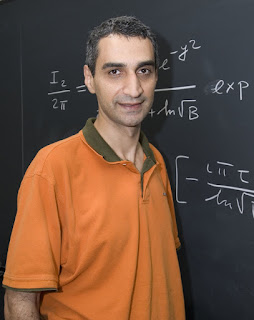Five-year, $625,000 Award is First for Rutgers; One of Two Awarded This Year in Physics
 | New Brunswick, N.J. – Rutgers physicist Emil Yuzbashyan has received a Packard Foundation Fellowship for Science and Engineering, which provides $625,000 in research funding for five years. This marks the first time the Packard Foundation has awarded this coveted fellowship to a Rutgers University professor. Yuzbashyan is among 20 fellows that the foundation selected from nominations at 50 of the nation’s top private and public research universities. |
“Having one of our faculty win this award is a landmark for Rutgers,” said Torgny Gustafsson, chair of the university’s physics and astronomy department. “This is an extremely competitive award – only 26 universities have hosted Packard fellows in physics during the award’s 19-year lifetime. We are pleased to be a part of that elite group.”
Yuzbashyan, who joined Rutgers in 2004 after earning his doctorate in physics from Princeton University, is studying properties of matter at temperatures close to absolute zero – the point where all motion ceases. Particles at these temperatures interact with each other in unusual ways; understanding those interactions could promote powerful new technologies such as quantum devices and superconductivity.
“Past recipients of Packard fellowships have had successful careers and become well known in their fields,” said Yuzbashyan. “The fellowship will help me build a skilled team of doctoral students, postdoctoral research fellows and visiting scientists to pursue this research and collaborate with others doing related work worldwide.”
Yuzbashyan’s research is in a branch of physics known as condensed matter physics, which deals with the physical properties of solid and liquid matter. He has recently developed a new theory related to superfluidity, or how a liquid cooled to near absolute zero can flow endlessly in a closed loop without any outside sources of energy to sustain that motion.
“Superfluidity was one of the biggest problems in physics – it took scientists many decades to solve,” he noted. “But their description was for situations where the superfluid is in equilibrium or in some way close to it; that is, where the unusual states of matter that we see near absolute zero are constant in time.”
Yuzbashyan’s latest research describes behavior of a superfluid that is far from being at equilibrium, or where states of matter are in the process of changing. In such systems, he and his colleagues predict they will see new states of matter that have not yet been observed. Future work will involve conducting experiments to create these environments and verify the matter and behaviors Yuzbashyan has proposed.
His other research interests include study of ultracold atoms and nanoparticles that exhibit atomic-level behaviors known as quantum properties.
A native of Armenia, Yuzbashyan earned his Master of Science degree from the Moscow Institute of Physics and Technology in 1995 and later worked at Russia’s Joint Institute for Nuclear Research. He came to the United States in 1998 to pursue his doctoral studies.
Yuzbashyan lives in Plainsboro, N.J.
Contact: Carl Blesch cblesch@ur.rutgers.edu 732-932-7084 x616. Rutgers, the State University of New Jersey
Technorati Tags: Nano or Nanotechnology and Nanotech and Rutgers, the State University of New Jersey or Packard Foundation Fellowship for Science and Engineering and quantum properties or In human grid, we're the cogs and The Crab Nebula and CU researchers shed light on light-emitting nanodevice














No comments:
Post a Comment